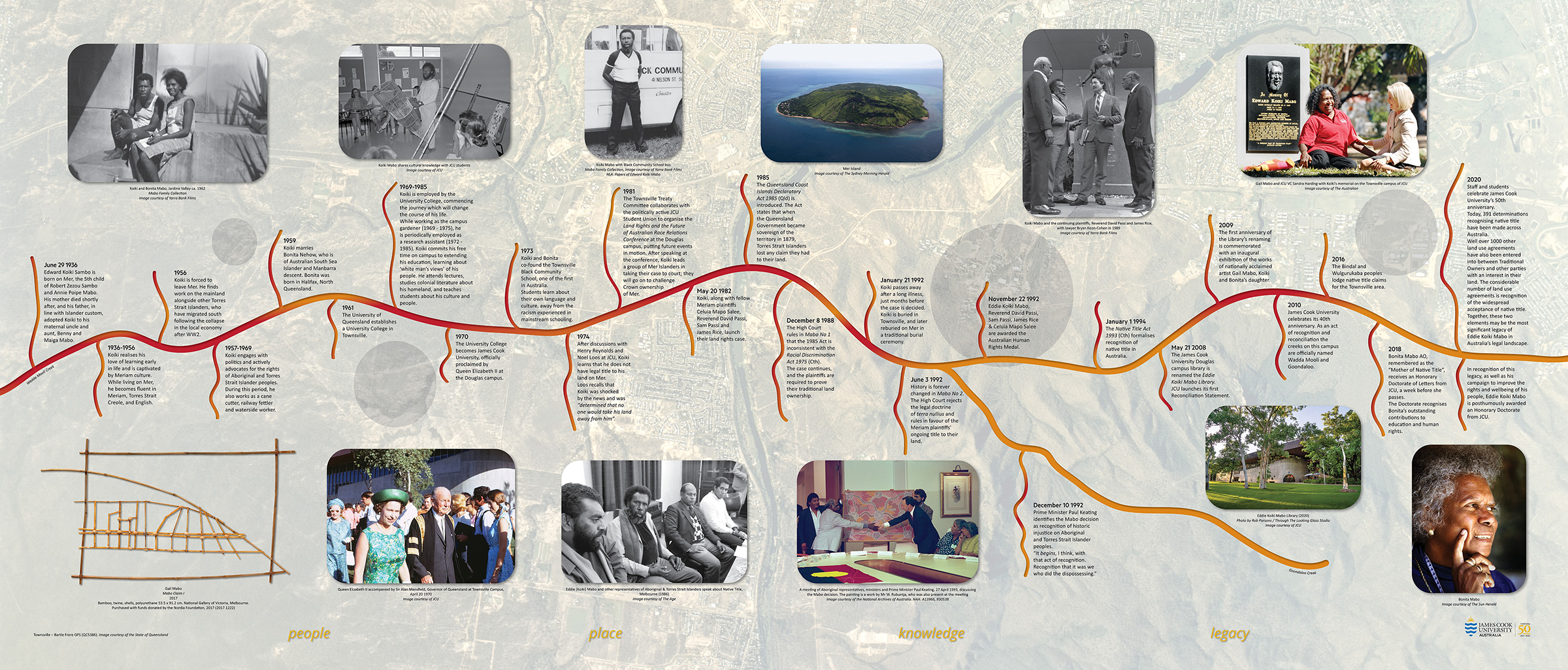NAIDOC Week takes place across Australia each year to celebrate the history, culture and achievements of Aboriginal and Torres Strait Islander peoples. This year we observe NAIDOC Week from 8-15 November due to COVID-19 restrictions in July.
The theme, Always Was, Always Will Be recognises that First Nations people have occupied and cared for the land we call Australia for over 65,000 years, managing the land for a sustainable future.
NAIDOC Week is a time to reflect on the importance of connection to country. We acknowledge the continuing legacies of the Bindal and the Wulgurukaba Peoples who are the original peoples of the Townsville region, and the Yirrganydji People, the original peoples of the Cairns region.
To mark the week this year we are sharing some of the work we have been doing that reflects the theme Always Was, Always Will Be.
Located in the Eddie Koiki Mabo Library, this permanent exhibition begins with the Birrigubba language welcome Wadda Moolli and an acknowledgement of First Nations people in particular the Bindal people who have lived on the land that the Townsville Campus Library occupies for thousands of generations. The serpentine flow of the timeline reflects Gubbula munda the carpet snake (python) that is the key Creation Spirit for the Bindal and Wulgurukaba people of the area. Always was. Always Will Be.
The timeline tells the story of the life and landmark court case of Eddie Koiki Mabo for whom the Townsville Campus Library was named in 2008. His and his co-claimants faith in their knowledge that on their home island of Mer was their own land and that it could not be claimed by the Australian Government led to the long and ultimately successful court case that declared Australia was not terra nullius (empty land) when it was claimed for the British Commonwealth. Always was. Always Will Be.

50 Treasures: Celebrating 50 Years of James Cook University
Several of the special treasures selected to be digitised and preserved within our reposititory NQHeritage are by Australian Aboriginal and Torres Strait Islander people and NAIDOC Week is an opportunity to share them with you and encourage you to take a closer look. Each item title will take you to the NQHeritage record and underneath you can read the post we shared at the time the treasure was released during 2020 that tells a slightly longer story.
For anyone in or near Townsville, you are warmly invited to see these pieces and more in the 50 Treasures exhibition at the Perc Tucker Gallery in the city centre, the exhibition runs until the 10th of January 2021.
The Torres Strait Islander Community
A precious treasure is a recorded lecture by Eddie Koiki Mabo speaking to a JCU class in the Race and Culture lecture series about the Torres Strait Islander Community. Bronwyn McBurnie was invited to answer the question, "why is this significant?"
Goobalathaldin Dick Roughsey Untitled bark painting.
Bruce Johnson McLean was invited to answer the question, "why is this significant?"
George Millpirrarruu The land is living, the past is present
Professor Joseph Reser was invited to answer the question, "why is this significant?"
John and Susan Page were invited to answer the question, "why is this significant?"
Dr Lynore Geia was invited to answer the question, "why is this significant?"
Marg Naylor was invited to answer the question, "why is this significant?"
That wraps up some special items that were curated this year by JCU Library and we hope you will view and share them.
Being a library we can't go without inviting you to take a look at some books that are a great opportunity to learn about the cultures of hundreds of Nations that have led the way in astronomy, exploration, navigation, engineering, farming, botany, science, diplomacy and art. The library has many relevant ebooks available for loan, including the bestselling Dark Emu by Bruce Pascoe, Aboriginal People and Their Plants by Philip A. Clarke and The Biggest Estate on Earth: How Aborigines Made Australia by Bill Gammage.
Wadda Moolli from the lands of the Birrigubba Nation.







Comments